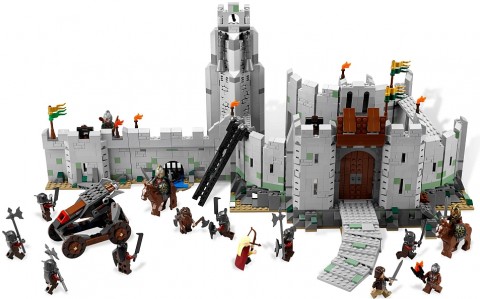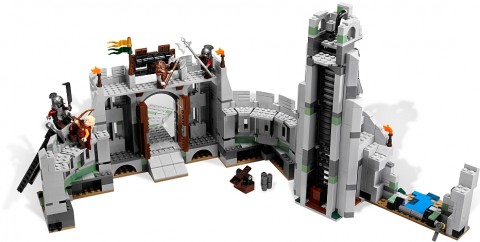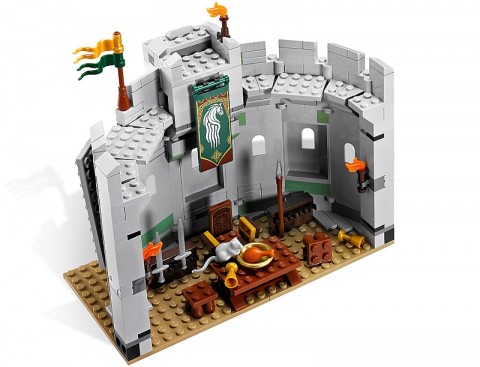(Written by William)
In the Brick Breakdown series I will be reviewing official LEGO sets but with a bit of a twist. Instead of just writing a general review I will focus on unusual and clever building-techniques LEGO designers used in the set. This way we can all learn new building ideas to use in our own LEGO creations, or at least get some inspiration to look at LEGO elements in a different way.

In this article I will show you the interesting building-techniques used in the #9474 LEGO Lord of the Rings Battle of Helm’s Deep set. Helm’s Deep is an iconic stronghold in an epic tale. It is a tribute to the idea of hope in the face of insurmountable odds. As profound as this notion is, it is a tough fortress with little in the ways of frills and excessive architectural splendor. This may be an odd choice to find interesting LEGO building-techniques, but they are present. So let’s take a look. 🙂
➡ UNUSUAL LEGO ELEMENT USAGE
Many times a LEGO element looks to be specifically designed to fulfill a particular purpose. For example the hub of a wheel is fit for very few other uses. However it can and does get selected for various LEGO designs; like thrusters on a LEGO space-ship or futuristic vehicle. Another example is using LEGO barred spindle fences as rungs on a ladder. It is quite common to see this technique used in LEGO sets. In addition, most LEGO builders will attempt to repurpose a LEGO element in nearly every LEGO model they create. In fact, discovering a new use for a LEGO element could be the sole inspiration behind a LEGO creation.

The rare technique in the LEGO Lord of the Rings Helm’s Deep set is when LEGO elements are used to form subtle designs in the building structure. Particularly for the various wall-panels to form narrow windows as well as textured walls within the main hall. It is fairly obvious that the design of these panels were to save on the production-cost of the parts since they use less plastic, but besides that LEGO has managed to use them in an entirely novel way. (Click images for larger view.)

In order to find similar versatility within your own LEGO elements, you may try looking for a part you have a good quantity of. Then you should position the pieces in a variety of orientations to study what the parts look like to you. This can be a very time consuming process. Sometimes a new idea just hits you right away, or it may take months to find several new uses for a LEGO element. You might also spend a bit of time looking at official LEGO sets to see if you notice any new or unusual ways a LEGO element is used that you can learn from.
➡ WORKING WITH LEGO HINGE & WEDGE CURVES
Those who have experimented with LEGO swivel hinge-plates and bricks to build curves may have run across a big issue with the technique. Often the curves formed are loose and tend to distort when moved around. Thankfully the LEGO Lord of the Rings Helm’s Deep set gives a variety of examples on how to improve curved LEGO walls.
The key is utilizing LEGO wedge plates. These elements provide a simple and effective locking affect when used with a hinge. The wedges set the angle that the hinge will be turned to without having to build a complicated balance.

The issue that most LEGO builders have is that many LEGO wedge-plates are hard to find. This makes the LEGO Lord of the Rings Battle of Helm’s Deep set an excellent choice to try out various curved designs; it comes with a good quantity of hinges and wedges in neutral colors. When examining the technique in the Helm’s Deep set look to find the wedges located near the top or bottom of the hinged sections.
➡ APPLYING WHAT YOU LEARN
As I mentioned earlier, it is a good idea to study images of official LEGO sets to spot unusual use of LEGO elements. The trick is learning to spot them. Sometimes it is done when a lot of the same LEGO elements being used, other times it is a single instance that may seem slightly strange to you until you think about why a particular piece was chosen. In the LEGO Lord of the Rings Battle of Helm’s Deep set the panel usage is both subtle and prolific which makes it a perfect example, yet hard to spot.
The LEGO hinge and wedge technique is a bit more specialized. You rarely find them in LEGO’s own product lines. They are more often present in licensed LEGO themes where a curved surface is needed to create an authentic replica of the model. The reason for the infrequent usage is that the curved formation is often less stable of a frame to work with. However it can prove to make some fantastic looking LEGO creations. 😀
I hope I helped you look at LEGO sets from a bit different angle. Instead of just building them according to the instructions and try to finish as fast as possible, it is a good idea to pause at times and study the building techniques used. This will make you appreciate LEGO sets even more and ultimately become a better free-builder. Looking at things with fresh eyes and thinking outside the box often leads to new discoveries.
What new LEGO building-techniques have you learned recently that you were excited about? Or did you discover a clever way to use a LEGO piece on your own? If you own the Helm’s Deep set, did you notice any other unique techniques? Feel free to share in the comment section below. Would love to hear about your own discoveries! 😉
And you might also like to check out the following related posts:
- LEGO Lord of the Rings Helm’s Deep Review
- 2013 LEGO Sets: LEGO Lord of the Rings
- How to Make Beautiful LEGO Trees
- Guide to Building a LEGO Castle Village
- LEGO Fairy Forest – Enchanted & Magical…
- LEGO Building Technique: Forced Perspective
- LEGO Building Technique: LEGO Water
- LEGO CUUSOO Project: LEGO Birds
- LEGO CUUSTOO Project: LEGO Animals













nice idea Will, I enjoy LOTR so I like this set and the review you did shows all the good elements it comes with, and I argee i like curveing my legos and it is hard!
It caught my attention because I had recently built a football stadium and the ease in which they show how to curve would have been really helpful when I made my design.
Glad you like my write-up. Hope to bring you more in the upcoming weeks!
Thanks,
Will
Nice post Will!
Thanks!
Admin,I know this is off topic but does Quad still use his site http://www.mocpages.com ?
I’m not sure. I haven’t heard from Quad for a while. He said he has been busy with other interests besides LEGO. 🙁
Oh no,he may have went into his dark ages again!
Also, were did LEGOLOTR go?
I’m not sure. I can’t track what people are doing. 😉
That was very helpful now I might be able to do better M.O.C.s
William you should continue to do more of these reviews because this was very helpful but don’t do videos because I always read the brick blogger on my tablet and I can’t watch the videos so this is the best and most helpful review ever
I plan to continue writing them and since I’m legally blind, it’s kind of hard for me to do videos. So, expect to see more breakdown articles just like this one. 🙂
Thanks!
The hinges-and-wedges technique is used beautifully in the Creator 31008 Thunder Wings set. The wings are held at an angle thanks to the use of multiple wedge plates for each wing. Check out the instructions and build it in LDD to see for yourselves.
That’s a good point. Many of these techniques are used in a variety of sets. Just like you pointed out, Mick.
Thanks for commenting!